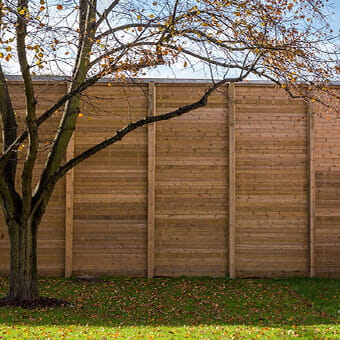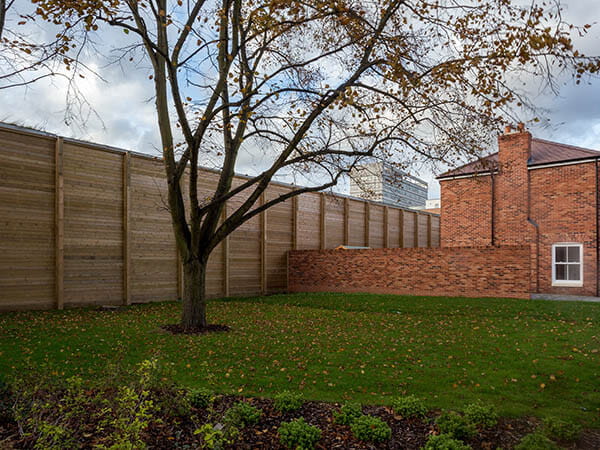Our other sites:
Acoustic barriers are designed to reduce the impact of environmental noise pollution, which has been shown to cause chronic stress, hearing damage, hypertension, diabetes and even heart problems.
According to the Chief Medical Officer, the level at which detrimental health effects become evident is 55 decibels, while WHO guidelines for night-time noise recommend less than 40 decibels to prevent adverse health effects. Quality acoustic barriers can reduce noise pollution by up to 32 decibels, but what makes an acoustic fence different from a standard timber fence? There are many types of acoustic barriers available, but here we compare timber acoustic barriers with timber garden fencing, as a similar looking product.
Acoustic fencing requirements
To be classified as an acoustic barrier, a surface mass density of at least 10kg/m2 is required, as this is the mass where noise will start to reflect back rather than be able to travel straight through. A typical timber fence has a mass of around 4kg/m2 and does not provide an effective barrier to reduce environmental noise. We have seen an increase of 'acoustic garden fencing', however the construction, surface mass density, and height of these fence panels likely means that this type of 'acoustic fencing' will not perform in the way that is desired. Also, think about the longevity and the quality of the fencing - any holes due to poor construction or resulting from insect attack, rot, or deterioration will reduce the performance of an acoustic fence as noise will be able to travel through the holes. If you are considering buying cheaper alternatives, do make sure that you ask for a copy of the noise test report, or better yet, ask for a demonstration of the fencing 'in action'.
At Jacksons, we have two types of timber acoustic barriers: reflective, which has a surface mass density of 25kg/m2, and absorptive which has a surface mass density of 28kg/m2. By default, a noise barrier without an additional absorptive layer is reflective.
By looking at a garden fence and an acoustic fence side-by-side, the differences will probably be obvious, but in a roundabout way: an acoustic fence will be taller, thicker, sturdier, and constructed in a way that stops gaps appearing over time, while a garden fence will be shorter, thinner, and the design will be different - it could have a slatted, woven, featherboard, or hit and miss style. None of these styles would make an effective acoustic barrier. An acoustic barrier must also never have any holes in it by design (we're sometimes asked about acoustic trellis).
The effectiveness of any noise barrier is dependent on five main factors:
There is a range of factors that differentiate a certified acoustic fence from a regular domestic fence; some key differences are explored below.
The imperviousness of acoustic barriers
Our acoustic fencing uses 34mm thick tongue-and-groove style ‘V’ boards constructed in such as way that eliminates gaps that sound can travel through. By comparison, a Tongue and Groove fence from Jacksons (our closest matching non-acoustic fence) is 17mm thick and has been designed for screening only, rather than noise reduction.
Regulations around acoustic fencing
At present, we are the only manufacturer in the UK able to UKCA mark a complete timber acoustic barrier system, ‘Jakoustic® Commercial and Highway’. This system includes the posts, cladding, fixings and installation, approved via an Initial Type Test Report carried out by BSI. In contrast, there are far fewer regulations around the installation of timber garden fencing, which is usually installed using slotted timber fence posts seen in gardens across the UK.
The lifespan of acoustic fencing
Finally, an acoustic barrier should have a lifespan of at least 20 years. All products manufactured by Jacksons Fencing, including timber barriers that are not acoustic fences, are covered by our 25 year Jakcure® guarantee.
Our acoustic barrier range
Jakoustic® Reflective, our original reflective acoustic barrier, first came to market in 2004, and has stayed true to its initial design ever since. Since then, our range has expanded to include Jakoustic® Absorptive, Jakoustic® Commercial and Highway, and 12K Envirofence®. Each barrier is specifically designed to reduce noise and is suitable for a wide range of applications. We also have a range of high security acoustic barriers which incorporate a layer of steel mesh but still have a similar outward appearance. As we've mentioned before, an acoustic consultant will be able to determine which type of barrier you need but our acoustic experts here at Jacksons will also be able to advise you. Someone common applications for each type of acoustic barrier are listed below:
If you think you may need an acoustic barrier for your site, explore our range, alternatively, if you think you just require a timber garden fence, view our wide range of timber fencing options.
Related products
Jacksons Security has a range of products relating to this article, all complete with our 25 year service life guarantee. If you cannot find the item you are looking for, please do not hesitate to call our friendly sales team.
Related Content
Top






